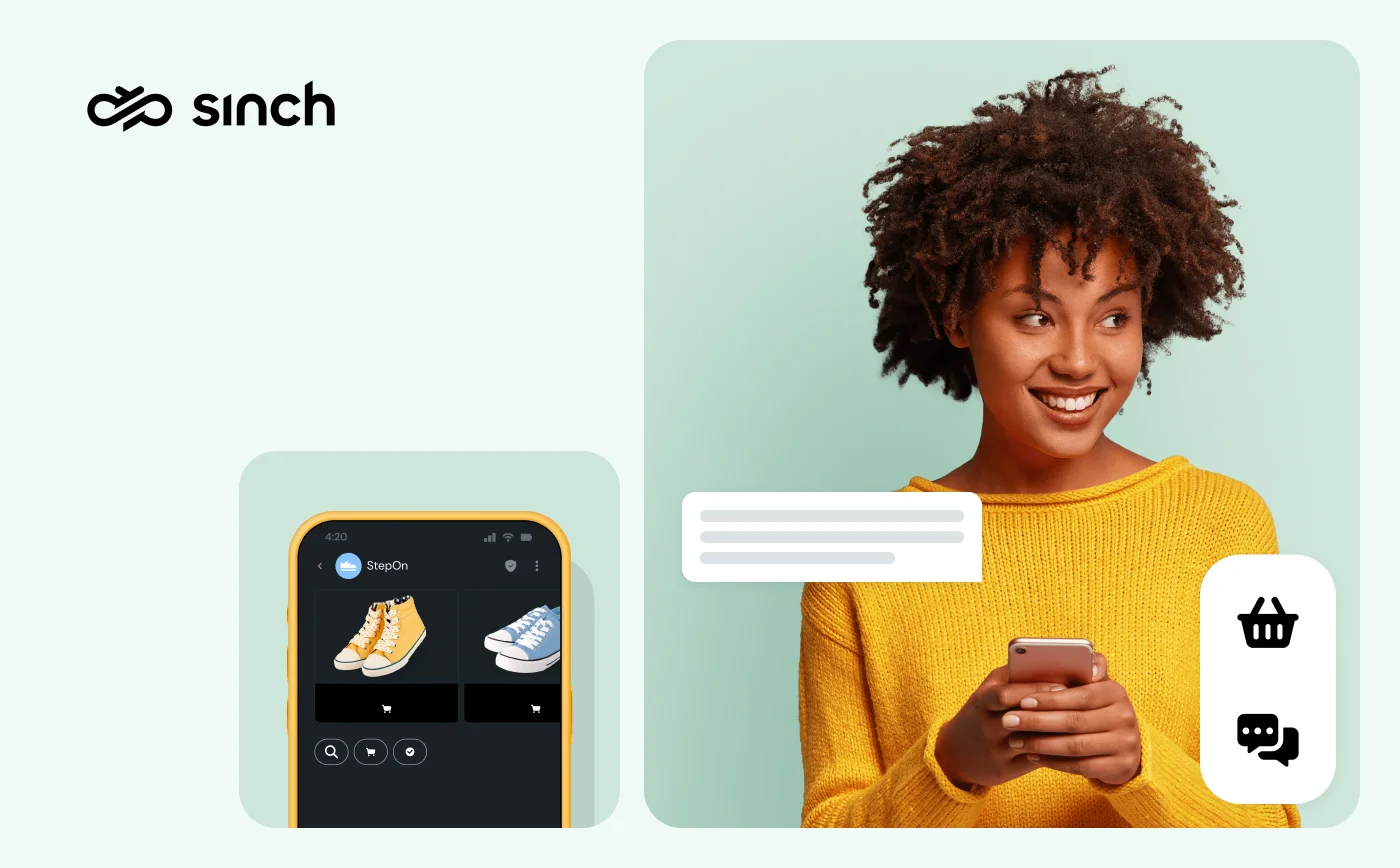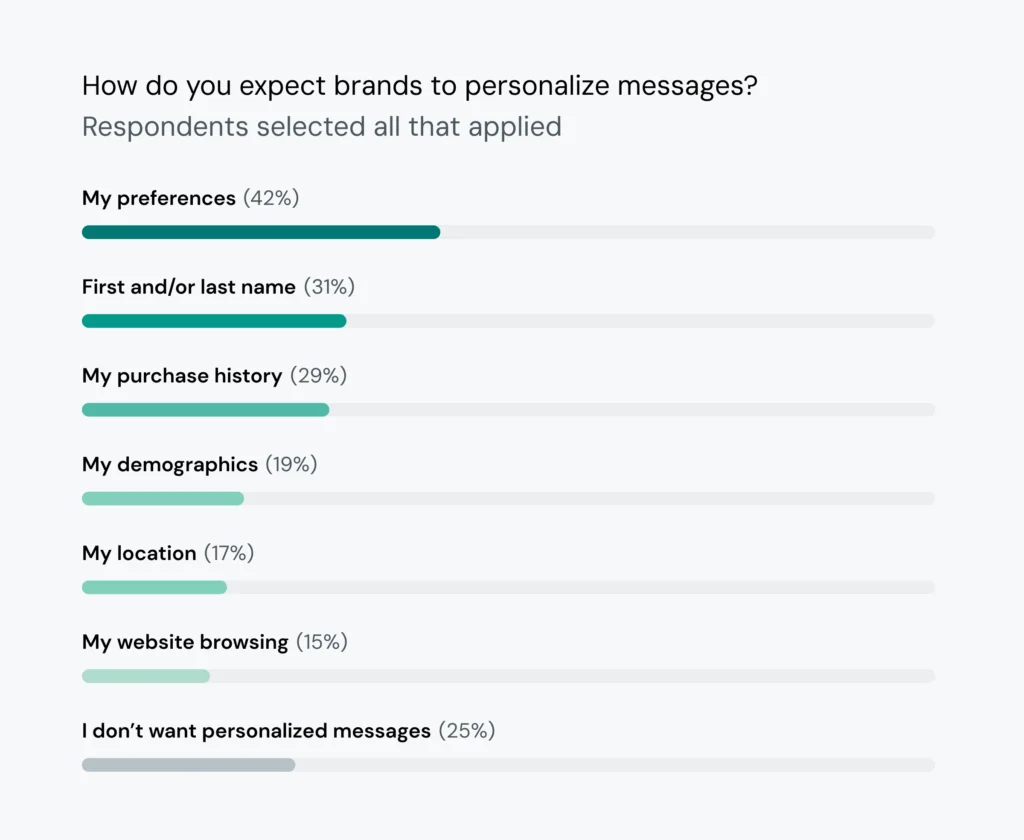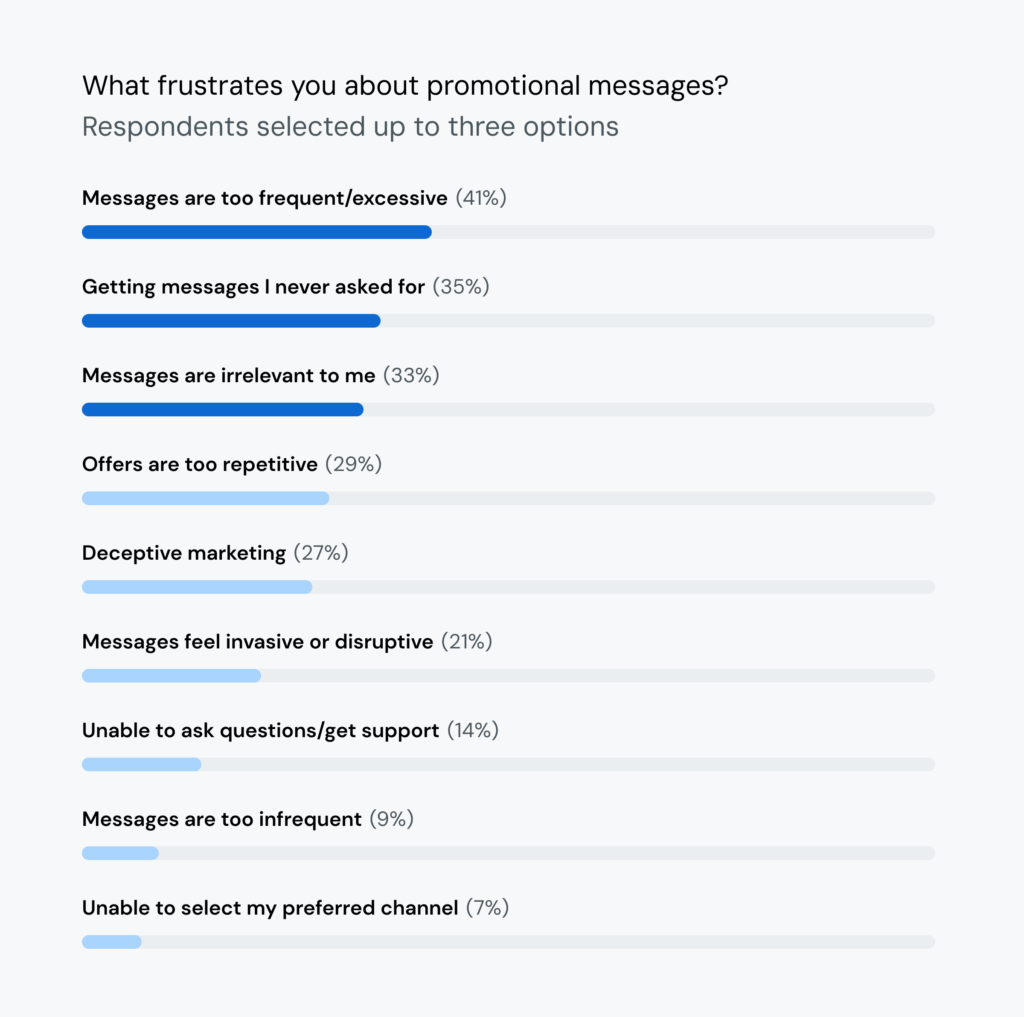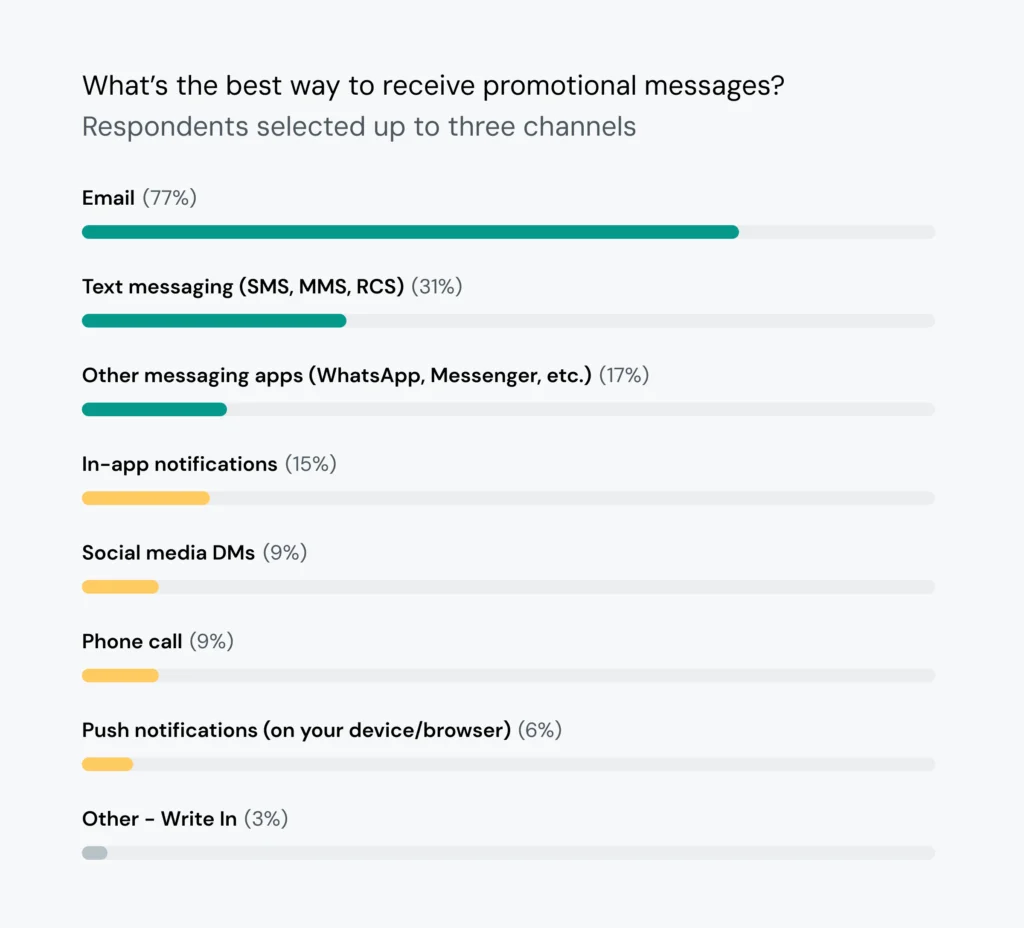Insights, Insights
Perfecting the personalized customer experience in 2025

Insights, Insights

Poor personalization efforts are driving customers away faster than ever. Companies throw around terms like “hyper-personalization” while delivering experiences that feel anything but personal.
Customers can smell fake personalization a mile away and here’s the proof: According to McKinsey, 76% of consumers get frustrated when businesses fail to recognize them as individuals. Yet most strategies still rely on surface-level tactics that customers see right through.
The good news? Sinch’s 2025 State of customer communications report surveyed over 2,800 global consumers and 1,600 business leaders to find the personalization practices businesses can replicate to earn trust and loyalty.
This post reveals how leading brands are using AI, behavioral data, and omnichannel messaging to create genuine experiences that customers actually want.
In 2025, omnichannel personalization goes beyond greeting every individual customer by name or sending a generic “we miss you” email.
A modern personalized customer experience is about providing interactions that are relevant, timely, and context-aware. They should draw on customer behavior, preferences, and history across all channels – from social media to in-store visits – used to engage with your brand.
McKinsey research shows that more than 70% of consumers now expect personalization from brands.
Our research further drills down into customer expectations when you talk about personalization. For example, 42% of consumers expect promotions to be personalized based on their preferences and 29% want offers based on their purchase history.

But consumers also want control.
They want to choose their communication channels, set their own frequency preferences, and decide what information they share. The brands getting this right collect just enough information to personalize communication without crossing the line.
So, what does striking that balance actually look like?
It’s the difference between blasting out a discount for running shoes because someone once bought gym shorts… versus knowing they’re training for a marathon through customer insights and sending race-day nutrition tips as personalized recommendations instead.
In 2025, the best personalization feels effortless: timely, relevant, and always aligned with the customer’s goals.
Personalization drives growth by strengthening the three pillars of sustainable business growth: trust, engagement, and loyalty.
It works because personalization shows customers you understand them – what they want, what they need, and when they need it.
When personalized service is respectful and relevant, customers stop seeing your brand as a sales machine and start seeing it as a service that enhances their digital experience. That shift builds customer loyalty: they share more customer feedback, engage more, and stay longer, increasing their lifetime value. Our research backs it up:
Taken together, these numbers show that customers value communication that feels personal, useful, and time-saving.
And here’s the most exciting signal: 16% of customers already see real value when brands use predictive analytics to anticipate their upcoming needs before they even ask. Think subscription renewals, seasonal personalized recommendations, or proactive maintenance notifications.
This predictive approach turns your brand into an indispensable part of their routine, creating customer loyalty that’s incredibly hard to break and improving conversion rates. That’s how you move from transactional to transformational relationships and build sustainable long-term growth.
Above all, consumers want personalization that respects their time, preferences, and boundaries.
They’ll share their data and engage with personalized content, but only if they get something meaningful in return. The key word being “meaningful,” which refers to relevance, respect, and delivery on their terms.
Our 2025 research found that 41% of consumers find excessive marketing messages frustrating, and 35% cite unwanted messages as their biggest promotional pain point.

Together, these frustrations reveal a common problem: too much noise, not enough relevance. When personalization misses the mark, customers tune out, trust erodes, and opportunities vanish.
But there’s a flip side. When personalization becomes interactive and actually helps customers make a decision, they lean in. For example, 24% want the ability to ask questions about promotions directly within messaging apps or through chatbots for self-service support. Your promotional content becomes a two-way conversation that helps customers make informed decisions.
Choice remains the common thread. 58% of customers want to select their preferred communication channel from the moment they opt in. They want to set the terms of engagement and expect you to honor them.
Customers will engage with personalization when it serves them, not when it serves your marketing calendar. Give them control over the experience, make interactions genuinely helpful, and they’ll reward you with attention and loyalty.
Don’t blast every message everywhere across all marketing campaigns. Match each message to generational communication preferences.
For example, our 2025 research has shown that 77% of consumers overall prefer email for marketing messages.

But 41% of Gen Z want promotional texts instead. For important informational messages, 24% want both email and SMS.
Redundancy becomes reassurance when the stakes are high. In other words, effective personalization depends on both who you’re talking to and what kind of message you’re sending.
That weekend sale? Perfect for email unless you’re talking to Gen Z, in which case a quick text might hit better. New purchase from an unrecognized device? Older generations will be okay with a text because they understand the urgency of the situation.
Channel strategy is just the beginning. Let’s walk through how to build a personalized experience from the ground up.
Before you personalize anything, decide what you’re trying to accomplish because your goal determines the kind of experience your customer gets, and the kind of return your business sees.
Are you trying to increase repeat purchases, reduce customer support tickets, or improve retention? Different goals call for different tactics.
Want fewer customer support tickets? Focus on proactive messaging automation that answers questions before customers ask them.
Chasing more repeat purchases? Track buying patterns and send timely reminders or complementary product suggestions.
Clarity upfront matters since it sets the entire strategy in motion. Start with one outcome, optimize for that, then expand.
If you want to personalize well, prioritize real behavior over assumed identity.
Skip the 47-question surveys and demographic deep dives. Focus on customer behavior that connects to your business goals and helps create detailed customer profiles.
Look for signals like:
If someone consistently opens emails but never clicks, they’re info-seeking rather than action-ready. Or if they abandon carts on mobile but complete purchases on desktop, your mobile experience needs attention.
These patterns tell you exactly where to improve and personalize. Ask simple, direct questions during real interactions like, “How would you like us to contact you with order updates?” That works better than a bloated preference center most people skip.
Collect only the customer data that changes how you communicate and allows you to create accurate customer segments for better targeting. Everything else is just extra work.
Plot out every interaction customers have with your brand during their customer journey, then focus on the ones where they’re most likely to stay… or leave.
Effective digital communication relies on ensuring that every customer connection is impactful, timely, and memorable. And that involves keeping customers engaged, informed, safe, and happy throughout their journey with your brand.
At each touchpoint you have with your customers, ask: How should they be feeling here?
Once you’ve mapped the pillars to your journey, zoom in on the high-stakes moments where personalization makes the biggest difference. These are your personalization power zones – the moments when relevance changes everything.
Think about the abandoned cart reminder that hits right as someone’s reconsidering or the shipping update that lands before they even wonder where their order is.
A well-timed, personal message shifts behavior. And you don’t need to personalize everything. Just nail the three or four moments where relevance turns hesitation into action and frustration into loyalty.
You can personalize the timing and the channel, but if the relevant content falls flat, the message won’t land.
A value-driven content plan delivers guidance, customer insights, and updates that are actually useful and improve the overall user experience. This is especially important in 2025, when 28% of consumers want helpful content tailored to their needs and 24% value product recommendations that make decisions easier.
of consumers want helpful content tailored to their needs.
value product recommendations that make decisions easier.
In other words, customers don’t want more content. They want smarter content.
To deliver it, you can segment based on real behavior and match the message to where they are in the journey:
The right content at the right time builds trust and keeps customers coming back.
You can hand-craft messages for 100 customers. But what about 10,000?
Personalization doesn’t scale on spreadsheets. You need tech that moves as fast as your audience.
44% of businesses already use artificial intelligence and machine learning algorithms to personalize, but it’s not just for product recs in e-commerce. AI automation can now:
Beyond AI, channels like Rich Communication Services (RCS) and WhatsApp provide richer, more engaging personalized interactions and help streamline communication.
RCS brings interactive buttons and product galleries directly into text messages. 59% of business leaders expect RCS messaging to significantly impact their customer communication strategies.
WhatsApp enables back-and-forth messaging where customers can ask questions and get immediate responses, turning omnichannel customer service into real-time problem solving.
Pick one technology that addresses your biggest personalization challenge first. If timing is your problem, start with AI scheduling. If engagement is low, try RCS interactive features. Learn that technology first before adding more layers to your strategy.
Set up tests that answer real questions about what’s working and what’s wasting time. Ask sharp, targeted questions that drive real improvement, like:
For example, a 40% open rate looks great until you realize no one’s buying. Similarly, click-throughs mean nothing if people bounce right after. Track metrics that connect directly to business outcomes – like purchases, conversions, and retention. Review your results monthly because what worked last month might flop today.
When something works, figure out why before you scale it. And when it doesn’t, tweak one variable at a time until you find what moves you forward.
Artificial intelligence isn’t here to replace the human touch in customer experience – it’s here to extend it. The real value of AI lies in its ability to take on routine, repetitive tasks at a scale no human team could match.
From segmenting audiences to scheduling messages at the right time, AI helps brands deliver more relevant customer interactions without adding headcount. That means customer-facing teams can spend less time on manual execution and more time on the moments that truly require empathy and human judgment.
Consumers are open to this kind of support when it’s used responsibly. In fact, 52% of people trust AI for simple tasks like order tracking and shipping updates. But that trust drops quickly when the stakes rise. In healthcare, for example, 64% of those hesitant to use AI don’t trust its accuracy, and 40% worry about privacy. These findings highlight an important truth: Businesses can’t treat AI as a one-size-fits-all personalization tool. It must be applied where it adds confidence, not doubt.
Forward-thinking brands are already investing here. In fact, 44% of companies across industries report using AI to personalize experiences today. As adoption accelerates, the winners will be the ones who combine AI’s speed and scale with clear boundaries, transparent data practices, and a commitment to keeping human connection at the center of the experience.
of consumers trust AI for tasks like order tracking and shipping updates.
of business leaders report using AI to personalize experiences today.
Richer mobile messaging channels like RCS and WhatsApp are redefining what personalization looks like in practice. Both offer verified sender profiles, logos, and trust marks that signal authenticity. And 42% of consumers say these indicators make them feel safer engaging with a brand.
For younger audiences, messaging apps are becoming the go-to channel: 28% of Gen Z and millennials prefer to receive promotions on apps like WhatsApp and Messenger. Beyond security and reach, these channels enable contextual micro-experiences – from interactive carousels to suggested replies – that feel immediate and relevant.
Combine trust with real-time interactivity, and you get conversations that feel human and drive action.
French furniture retailer BUT shows how omnichannel messaging creates seamless customer experiences.
When Rich SMS failed to explain their “100% Refunded” promo clearly, BUT switched to RCS. With animated visuals and richer content, they clarified the message and captured more attention.
And it paid off:
BUT used each channel’s strengths to create smooth, smart, omnichannel experiences.
In 2025, the brands that win aren’t those with the most data or the most channels. They’re the ones that use personalization to make customers feel engaged, informed, safe, and happy at the moments that matter most.
Instead of adding touchpoints or collecting more info, focus on what customers value and deliver it consistently, in the channels they prefer.
Your next step is simple: Pick one element from this guide and test it within 30 days. Whether it’s mapping your customer journey around the four pillars, testing AI-powered send times, or launching RCS interactive messages, start with what solves your biggest customer experience challenge.
Want to see how top brands are reducing support costs, increasing revenue, and building loyalty through smarter personalization? See how companies across industries are building messaging experiences that work in every channel, for every customer.